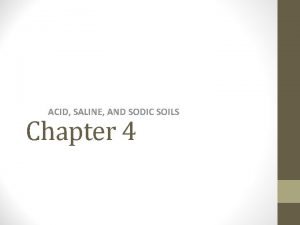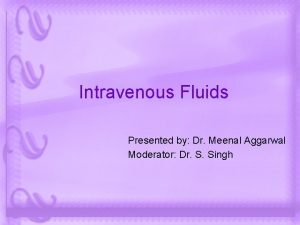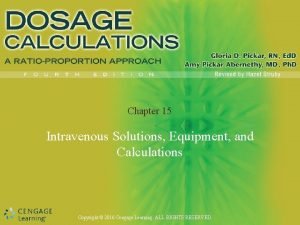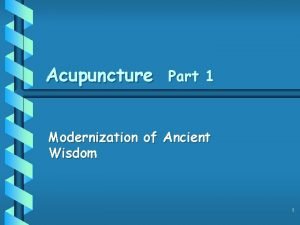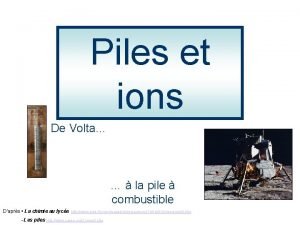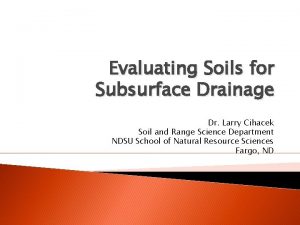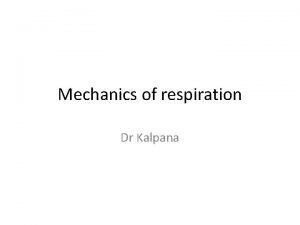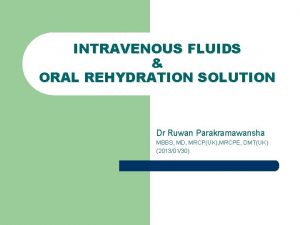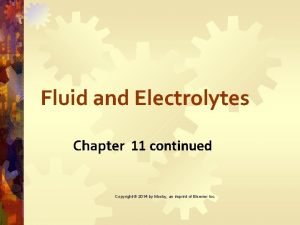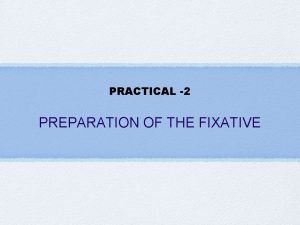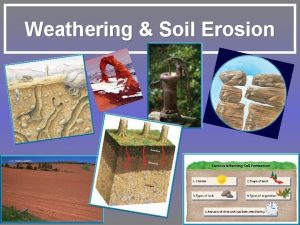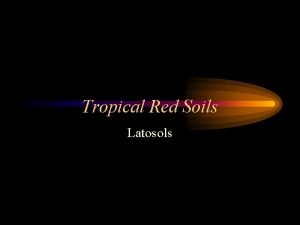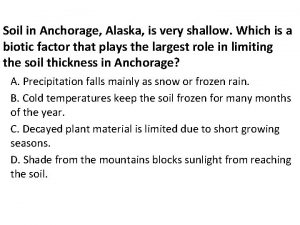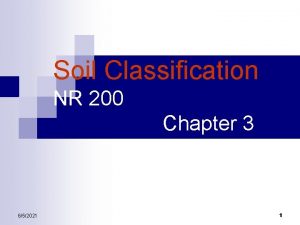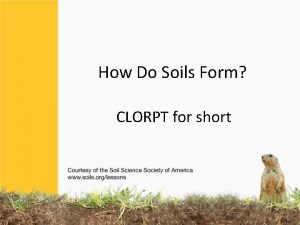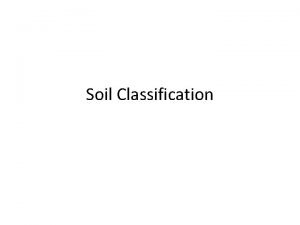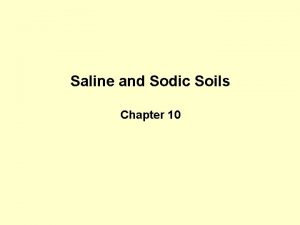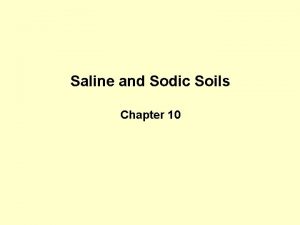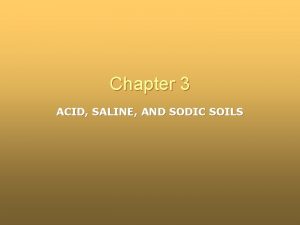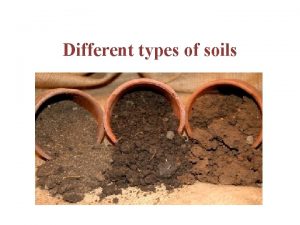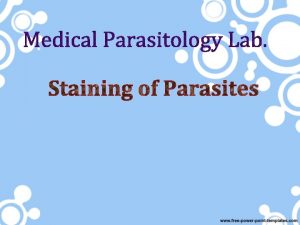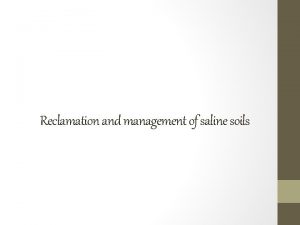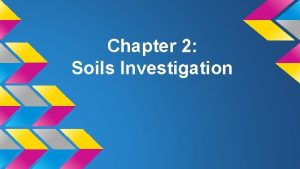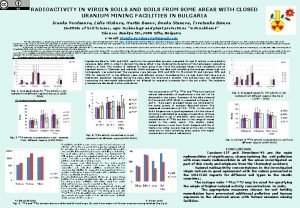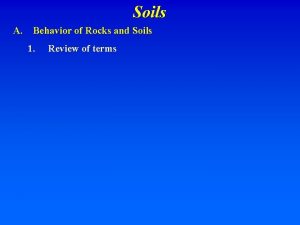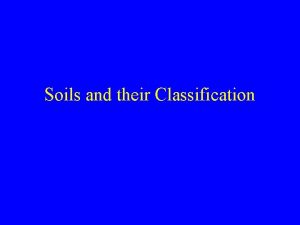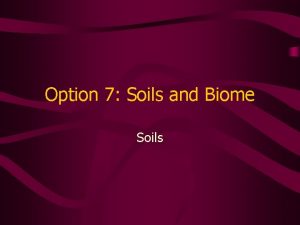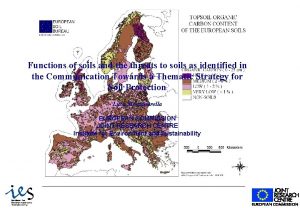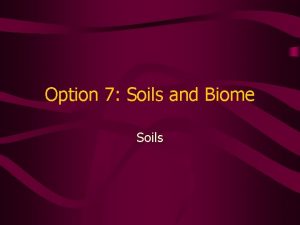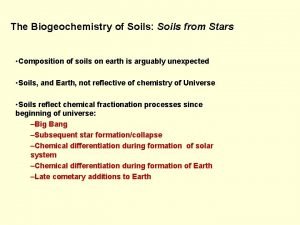Saline and Sodic Soils Chapter 10 This one























- Slides: 23

Saline and Sodic Soils Chapter 10


This one.

Percent yield on y-axis and increasing level of salinity on x-axis.


OK, you can have natural salinity, especially where salts may concentrate, like in a seep area, but you can also salinize a soil with long-term irrigation. This has ruined many an acre, around the world. There also sodium-affected soils and a combination.

Say you add a bit of salt with an irrigation. Next time you irrigate, add more water than just enough to wet the root zone and water percolates deeper, dissolving and leaching the salt from the previous irrigation. Of course, to make this design work, you need good internal drainage.

For salinity For sodicity

EC increase with concentration of electrolyte, right? Pure water is a poor conductor of electricity. The units of measurement are d. S / m. Work at the USDA Salinity Lab in California showed that conductivity is (on a log-log basis) related to ionic strength, and the latter is something of a measure of electrolyte concentration.

This is an older measure of sodicity that has been replace in soil testing labs by an easier but indirect measure (sodium adsorption ration, next slide). Note the similarity of ESP with %BS.

The above threshold may seem surprising but the basis is that even a 15% saturation of the CEC with Na means that there is little Ca- or Mg. CO 3 in the soil. Since both Ca 2+ and Mg 2+ are strongly preferred to Na+ adsorption, if there was appreciable Ca- or Mg. CO 3 present, the ESP would be lower. Further, in the absence of solid phase Ca- or Mg. CO 3, the p. H is not controlled by carbonate equilibria (keeping it about 8. 5) so that it increases to plant-bad values.

The basis of this is something called the Gapon model, which is empirical, Na. Ex / (Ca. Ex + Mg. Ex) = k [Na+] / ([Ca 2+] + [Mg 2+])1/2 The left hand side is close to ESP, Na. Ex / (Ca. Ex + Mg. Ex + Na. Ex + …) = Na. Ex / CEC


Sodic Not Affected Saline and Sodic Saline SAR = 13 ESP = 15 EC = 4

Salt deposited on surface of soil when water evaporates = white.




Na is a dispersing cation. It is not tightly held to negatively charged colloids (figure left is supposed to show 2 parallel colloidal particles, one pair with tightly held Ca 2+ and one With loosely held Na+, off-setting the particle negative charge. Notice that for the Ca 2+, the repulsive negative charges are shielded by a concentrated Ca 2+ zone but not so for the diffuse Na+ zone. So, Ca 2+ is flocculating, Na+ dispersing. However, if the concentration of cation charge is sufficiently high, even with Na+ (figure to right), the negative charge of adjacent particles is effectively shielded so that particles can closely approach, i. e. , are flocculated. But decrease that high concentration and they disperse.



No, colloids dispersed and hydraulic conductivity too small. No, here too. See previous slide.

█2 Na+ + Ca 2+ █Ca 2+ + 2 Na+ Notice, also, that a solid phase of Ca. CO 3 forms, thereby dropping p. H to ~ 8. 5. So, there is a use for gypsum besides drywall.
 Sodic acid
Sodic acid Saline cathartics
Saline cathartics Maintenance fluid formula 4-2-1
Maintenance fluid formula 4-2-1 How do you calculate iv flow rate?
How do you calculate iv flow rate? Normal saline order example
Normal saline order example Saline cathartics
Saline cathartics Saline meaing
Saline meaing Schéma pile volta
Schéma pile volta Saline soil
Saline soil Isotonic bicarbonate
Isotonic bicarbonate Lung compliance
Lung compliance Never wear socks
Never wear socks Hypotonic iv solution
Hypotonic iv solution Lactated ringers vs normal saline
Lactated ringers vs normal saline Saline district library
Saline district library Formal saline fixative
Formal saline fixative The rate of weathering depends upon the area's ____.
The rate of weathering depends upon the area's ____. Red latosol
Red latosol What is soil?
What is soil? Anchorage soil
Anchorage soil Prairie soils (mollisols) are _______.
Prairie soils (mollisols) are _______. Use of continuous tubular rail as a barrier to excavations
Use of continuous tubular rail as a barrier to excavations Ciorpt
Ciorpt Classification of soils
Classification of soils
